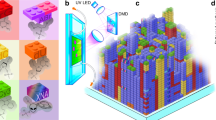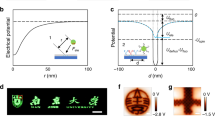Abstract
The challenge of constructing surfaces with nanostructured chemical functionality is central to many areas of biology and biotechnology. This protocol describes the steps required for performing molecular printing using polymer pen lithography (PPL), a cantilever-free scanning probe-based technique that can generate sub-100-nm molecular features in a massively parallel fashion. To illustrate how such molecular printing can be used for a variety of biologically relevant applications, we detail the fabrication of the lithographic apparatus and the deposition of two materials, an alkanethiol and a polymer onto a gold and silicon surface, respectively, and show how the present approach can be used to generate nanostructures composed of proteins and metals. Finally, we describe how PPL enables researchers to easily create combinatorial arrays of nanostructures, a powerful approach for high-throughput screening. A typical protocol for fabricating PPL arrays and printing with the arrays takes 48–72 h to complete, including two overnight waiting steps.
This is a preview of subscription content, access via your institution
Access options
Subscribe to this journal
Receive 12 print issues and online access
$259.00 per year
only $21.58 per issue
Buy this article
- Purchase on Springer Link
- Instant access to full article PDF
Prices may be subject to local taxes which are calculated during checkout






Similar content being viewed by others
References
Tran, H., Killops, K.L. & Campos, L.M. Advancements and challenges of patterning biomolecules with sub-50 nm features. Soft Matter 9, 6578–6586 (2013).
Schmidt, R.C. & Healy, K.E. Controlling biological interfaces on the nanometer-length scale. J. Biomed. Mater. Res. A 90A, 1252–1261 (2009).
Kim, D.-H., Lee, H., Lee, Y.K., Nam, J.-M. & Levchenko, A. Biomimetic nanopatterns as enabling tools for analysis and control of live cells. Adv. Mater. 22, 4551–4566 (2010).
Kumar, A., Biebuyck, H.A. & Whitesides, G.M. Patterning self-assembled monolayers: applications in materials science. Langmuir 10, 1498–1511 (1994).
Kumar, A. & Whitesides, G.M. Features of gold having micrometer to centimeter dimensions can be formed through a combination of stamping with an elastomeric stamp and an alkanethiol 'ink' followed by chemical etching. Appl. Phys. Lett. 63, 2002–2004 (1993).
Wilbur, J.L., Kumar, A., Kim, E. & Whitesides, G.M. Microfabrication by microcontact printing of self-assembled monolayers. Adv. Mater. 6, 600–604 (1994).
Xia, Y. & Whitesides, G.M. Soft lithography. Angew. Chem. Int. Ed. 37, 550–575 (1998).
Qin, D., Xia, Y. & Whitesides, G.M. Soft lithography for micro- and nanoscale patterning. Nat. Protoc. 5, 491–502 (2010).
Huo, F.W. et al. Polymer pen lithography. Science 321, 1658–1660 (2008).
Barbulovic-Nad, I. et al. Bio-microarray fabrication techniques—a review. Crit. Rev. Biotechnol. 26, 237–259 (2006).
Allain, L.R., Stratis-Cullum, D.N. & Vo-Dinh, T. Investigation of microfabrication of biological sample arrays using piezoelectric and bubble-jet printing technologies. Anal. Chim. Acta 518, 77–85 (2004).
Park, J.-U. et al. High-resolution electrohydrodynamic jet printing. Nat. Mater. 6, 782–789 (2007).
Salaita, K. et al. Massively parallel dip-pen nanolithography with 55,000-pen two-dimensional arrays. Angew. Chem. Int. Ed. 45, 7220–7223 (2006).
Salaita, K., Wang, Y.H. & Mirkin, C.A. Applications of dip-pen nanolithography. Nat. Nanotechnol. 2, 145–155 (2007).
Giam, L.R. & Mirkin, C.A. Cantilever-free scanning probe molecular printing. Angew. Chem.Int. Ed. 50, 7482–7485 (2011).
Braunschweig, A.B., Huo, F. & Mirkin, C.A. Molecular printing. Nat. Chem. 1, 353–358 (2009).
Wilbur, J.L., Kim, E., Xia, Y. & Whitesides, G.M. Lithographic molding: A convenient route to structures with sub-micrometer dimensions. Adv. Mater. 7, 649–652 (1995).
Jung Moo, H., Fatih, M.O. & Jun, Z. A micromachined elastomeric tip array for contact printing with variable dot size and density. J. Micromech. Microeng. 18, 015003 (2008).
Xie, Z. et al. Polymer pen lithography using dual-elastomer tip arrays. Small 8, 2664–2669 (2012).
Shim, W. et al. Hard-tip, soft-spring lithography. Nature 469, 516–521 (2011).
Shim, W. et al. Multifunctional cantilever-free scanning probe arrays coated with multilayer graphene. Proc. Natl. Acad. Sci. USA 109, 18312–18317 (2012).
Eichelsdoerfer, D.J., Brown, K.A., Boya, R., Shim, W. & Mirkin, C.A. Tuning the spring constant of cantilever-free tip arrays. Nano Lett. 13, 664–667 (2013).
Huo, F.W. et al. Beam pen lithography. Nat. Nanotechnol. 5, 637–640 (2010).
Brown, K.A. et al. A cantilever-free approach to dot-matrix nanoprinting. Proc. Natl. Acad. Sci. USA 110, 12921–12924 (2013).
Liao, X., Braunschweig, A.B. & Mirkin, C.A. 'Force-Feedback' leveling of massively parallel arrays in polymer pen lithography. Nano Lett. 10, 1335–1340 (2010).
Ginger, D.S., Zhang, H. & Mirkin, C.A. The evolution of dip-pen nanolithography. Angew. Chem. Int. Ed. 43, 30–45 (2004).
Giam, L.R. et al. Scanning probe-enabled nanocombinatorics define the relationship between fibronectin feature size and stem cell fate. Proc. Natl. Acad. Sci. USA 109, 4377–4382 (2012).
Zhong, X. et al. Materials for the preparation of polymer pen lithography tip arrays and a comparison of their printing properties. J. Pol. Sci. A 51, 1533–1539 (2013).
Huang, L. et al. Matrix-assisted dip-pen nanolithography and polymer pen lithography. Small 6, 1077–1081 (2010).
Bian, S., He, J., Schesing, K.B. & Braunschweig, A.B. Polymer pen lithography (PPL)-induced site-specific click chemistry for the formation of functional glycan arrays. Small 8, 2000–2005 (2012).
Bian, S., Schesing, K.B. & Braunschweig, A.B. Matrix-assisted polymer pen lithography–induced Staudinger ligation. Chem. Commun. 48, 4995–4997 (2012).
Chai, J.A. et al. Scanning probe block co-polymer lithography. Proc. Natl. Acad. Sci. USA 107, 20202–20206 (2010).
Giam, L.R. et al. Positionally defined, binary semiconductor nanoparticles synthesized by scanning probe block copolymer lithography. Nano Lett. 12, 1022–1025 (2012).
Brinkmann, F. et al. Interdigitated multicolored bioink micropatterns by multiplexed polymer pen lithography. Small 9, 3266–3275 (2013).
Zheng, Z. et al. Multiplexed protein arrays enabled by polymer pen lithography: addressing the inking challenge. Angew. Chem. Int. Ed. 48, 7626–7629 (2009).
Chai, J., Wong, L.S., Giam, L. & Mirkin, C.A. Single-molecule protein arrays enabled by scanning probe block co-polymer lithography. Proc. Natl. Acad. Sci. USA 108, 19521–19525 (2011).
Bian, S. et al. Covalently patterned graphene surfaces by a force-accelerated Diels-Alder reaction. J. Am. Chem. Soc. 135, 9240–9243 (2013).
Lee, K.-B., Park, S.-J., Mirkin, C.A., Smith, J.C. & Mrksich, M. Protein nanoarrays generated by dip-pen nanolithography. Science 295, 1702–1705 (2002).
Wilson, D.L. et al. Surface organization and nanopatterning of collagen by dip-pen nanolithography. Proc. Natl. Acad. Sci. USA 98, 13660–13664 (2001).
Lee, K.-B., Lim, J.-H. & Mirkin, C.A. Protein nanostructures formed via direct-write dip-pen nanolithography. J. Am. Chem. Soc. 125, 5588–5589 (2003).
Sekula, S. et al. Multiplexed lipid dip-pen nanolithography on subcellular scales for the templating of functional proteins and cell culture. Small 4, 1785–1793 (2008).
Cheung, C.L. et al. Fabrication of assembled virus nanostructures on templates of chemoselective linkers formed by scanning probe nanolithography. J. Am. Chem. Soc. 125, 6848–6849 (2003).
Shikida, M., Sato, K., Tokoro, K. & Uchikawa, D. Comparison of anisotropic etching properties between KOH and TMAH solutions. in Twelfth IEEE International Conference on Micro Electro Mechanical Systems, 1999 (MEMS '99). 315–320 (1999).
Schmid, H. & Michel, B. Siloxane polymers for high-resolution, high-accuracy soft lithography. Macromolecules 33, 3042–3049 (2000).
Acknowledgements
This material is based on the work supported by the US Defense Advanced Research Projects Agency (DARPA) Microsystems Technology Office (MTO) award N66001-08-1-2044; Asian Office of Aerospace Research and Development (AOARD) award FA2386-10-1-4065; Air Force Office of Scientific Research (AFOSR) awards FA9550-12-1-0280 and FA9550-12-1-0141; US National Science Foundation awards DBI-1152139, DBI-1152169 and DMB-1124131; Department of Defense (DoD)/Naval Postgraduate School (NPS)/National Security Science and Engineering Faculty (NSSEF) fellowship awards N00244-09-1-0012 and N00244-09-1-0071; Chicago Biomedical Consortium with support from Searle Funds at The Chicago Community Trust; and Center of Cancer Nanotechnology Excellence (CCNE) initiative of the US National Institutes of Health (NIH) award U54 CA151880. D.J.E. is supported by a DoD, Air Force Office of Scientific Research, National Defense Science and Engineering Graduate Fellowship (NDSEG) 32 CFR 168a. X.L. gratefully acknowledges support from the Ryan Fellowship from Northwestern University. K.A.B. gratefully acknowledges support from Northwestern University's International Institute for Nanotechnology. B.R. acknowledges the Indo-US Science and Technology Forum (IUSSTF) for a postdoctoral fellowship. L.R.G. acknowledges the NSF for a Postdoctoral Research Fellowship in Biology.
Author information
Authors and Affiliations
Contributions
D.J.E., X.L., K.A.B., L.R.G., A.B.B. and C.A.M. are responsible for the preparation of the paper. D.J.E., X.L., M.D.C., W.M., B.R. and K.A.B. are responsible for the experiments described in this paper.
Corresponding author
Ethics declarations
Competing interests
The authors declare no competing financial interests.
Rights and permissions
About this article
Cite this article
Eichelsdoerfer, D., Liao, X., Cabezas, M. et al. Large-area molecular patterning with polymer pen lithography. Nat Protoc 8, 2548–2560 (2013). https://doi.org/10.1038/nprot.2013.159
Published:
Issue Date:
DOI: https://doi.org/10.1038/nprot.2013.159
This article is cited by
-
Luminescent nanoparticle-arrays synthesized via polymer pen lithography
Nano Research (2023)
-
Relay-type sensing mode: A strategy to push the limit on nanomechanical sensor sensitivity based on the magneto lever
Nano Research (2023)
-
Binary-state scanning probe microscopy for parallel imaging
Nature Communications (2022)
-
Massively parallel cantilever-free atomic force microscopy
Nature Communications (2021)
-
Printing High-resolution Micro-patterns by Solution Processes
Chemical Research in Chinese Universities (2021)
Comments
By submitting a comment you agree to abide by our Terms and Community Guidelines. If you find something abusive or that does not comply with our terms or guidelines please flag it as inappropriate.



